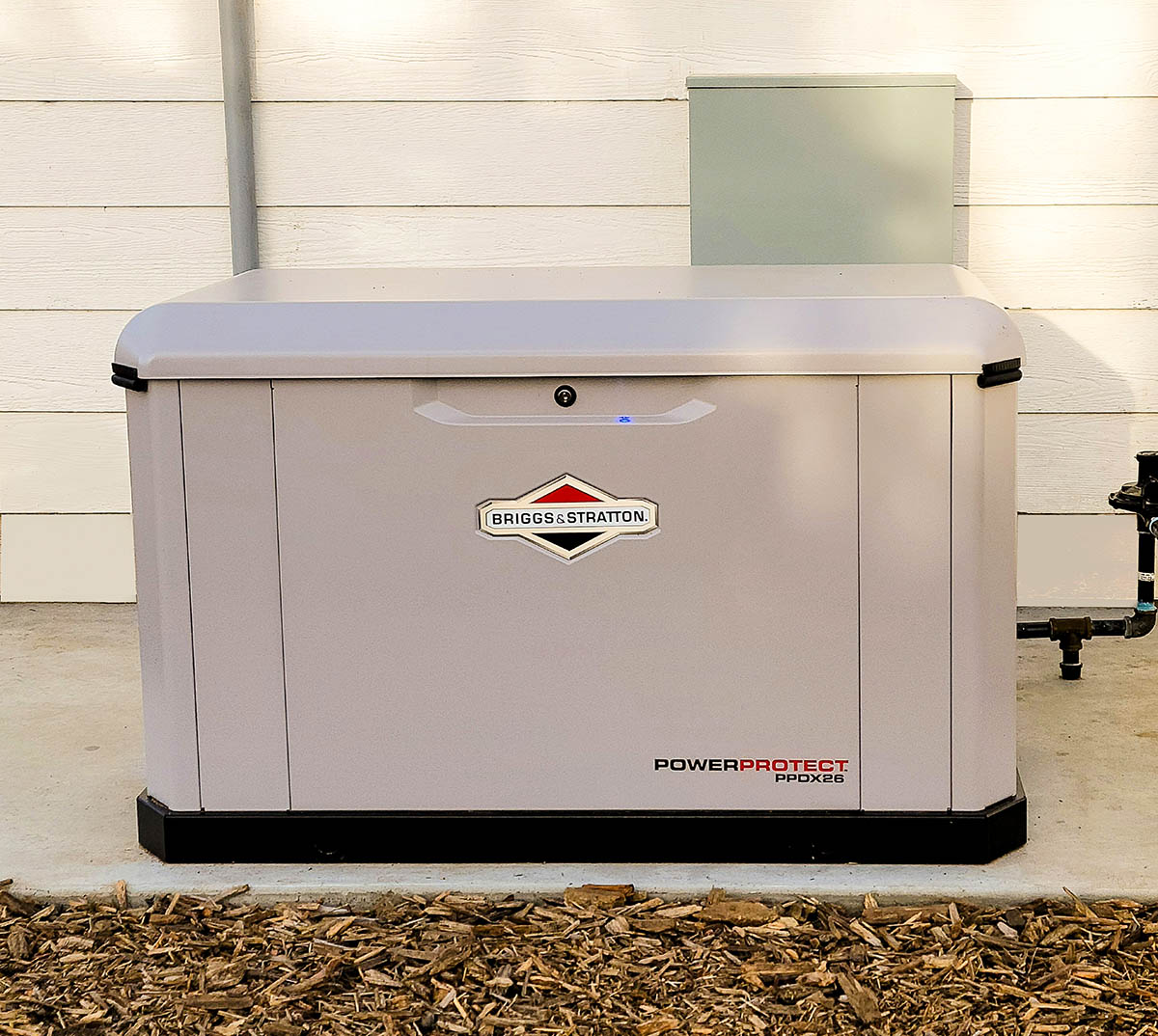

We may earn revenue from the products available on this page and participate in affiliate programs. Learn More ›
As the risk of power outages and rolling blackouts increases, due in part to an aging electrical grid and an increase in weather events that interrupt power, homeowners are looking for ways to protect their homes and families from unexpected loss of power. Portable generators that run on diesel or gasoline can help power small appliances or maybe a few space heaters in a pinch, but they don’t provide enough electricity to keep a whole household running.
Enter the standby generator. Also called a whole-house generator, this backup power producer is designed to provide enough electricity to power an entire house in the event of a power outage. We wanted to know just how efficient a standby generator could be, so we installed and tested the Briggs & Stratton PowerProtect 26kW Standby Generator.
Installing a standby generator isn’t a DIY project—at least not totally—although enthusiastic DIYers can do some of the work to help reduce installation costs. Ahead, learn how to get the right standby generator for your home’s needs, and find out what happened when we installed and tested the Briggs & Stratton standby generator.
The Briggs & Stratton standby generator: At a Glance
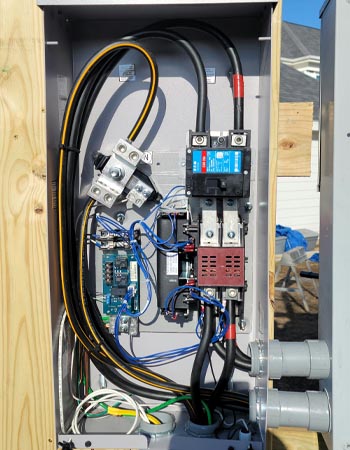
Rating: 9.4/10
PROS
- The generator turns on automatically within seconds of a power outage
- The unit supplies ample power to run all appliances, including HVAC
- Users can configure the Briggs & Stratton generator to run weekly self-tests
CONS
- The unit is very heavy and care must be taken when moving it
- The generator must not be installed inside a garage, shed, or other enclosure
- Local codes may require licensed pros to hook up wiring and gas lines
Find an authorized Briggs & Stratton standby generator dealer.
Get Briggs & Stratton generators in various sizes at:
- FactoryPure (10kW) for $3,329
- Lowe’s (12kW) for $4,299
- Electric Generators Direct (17kW) for $5,199
- Lowe’s (26kW) for $6,699
What is the Briggs & Stratton Standby Generator?
For many, the name “Briggs & Stratton” is synonymous with high-quality small engines. Indeed, the company’s engines are found in a vast array of today’s power equipment, including lawn mowers, snow blowers, and other lawn and garden machines.
My husband, John, a general contractor, and I have long been fans of Briggs & Stratton engines, so we were excited at the opportunity to install and test one of the company’s standby generators. The unit we installed was the Briggs & Stratton PowerProtect PPDX26, a behemoth of a power producer that’s available from dealers nationwide as well as at home improvement centers such as Lowe’s and Electric Generators Direct.
The generator we tested was designed to be permanently installed and connected to a home’s electrical system and either a natural gas line or a propane line. In our case, it’s connected to propane. When the power goes out, the generator detects the drop in electricity and automatically kicks on, beginning the job of converting propane to electricity. When power from the utility comes back on, the standby generator stops generating electricity and allows the utility to supply power to the house once again.
That’s a simplified explanation of how the generator works—many will still have questions about specifics, such as sizing, installation, and location requirements. In addition to our hands-on testing, we consulted with Matt Buff, Senior Trainer Standby Power for Briggs & Stratton. Buff walked us through some of the installation requirements and familiarized us with the backup generator’s features.
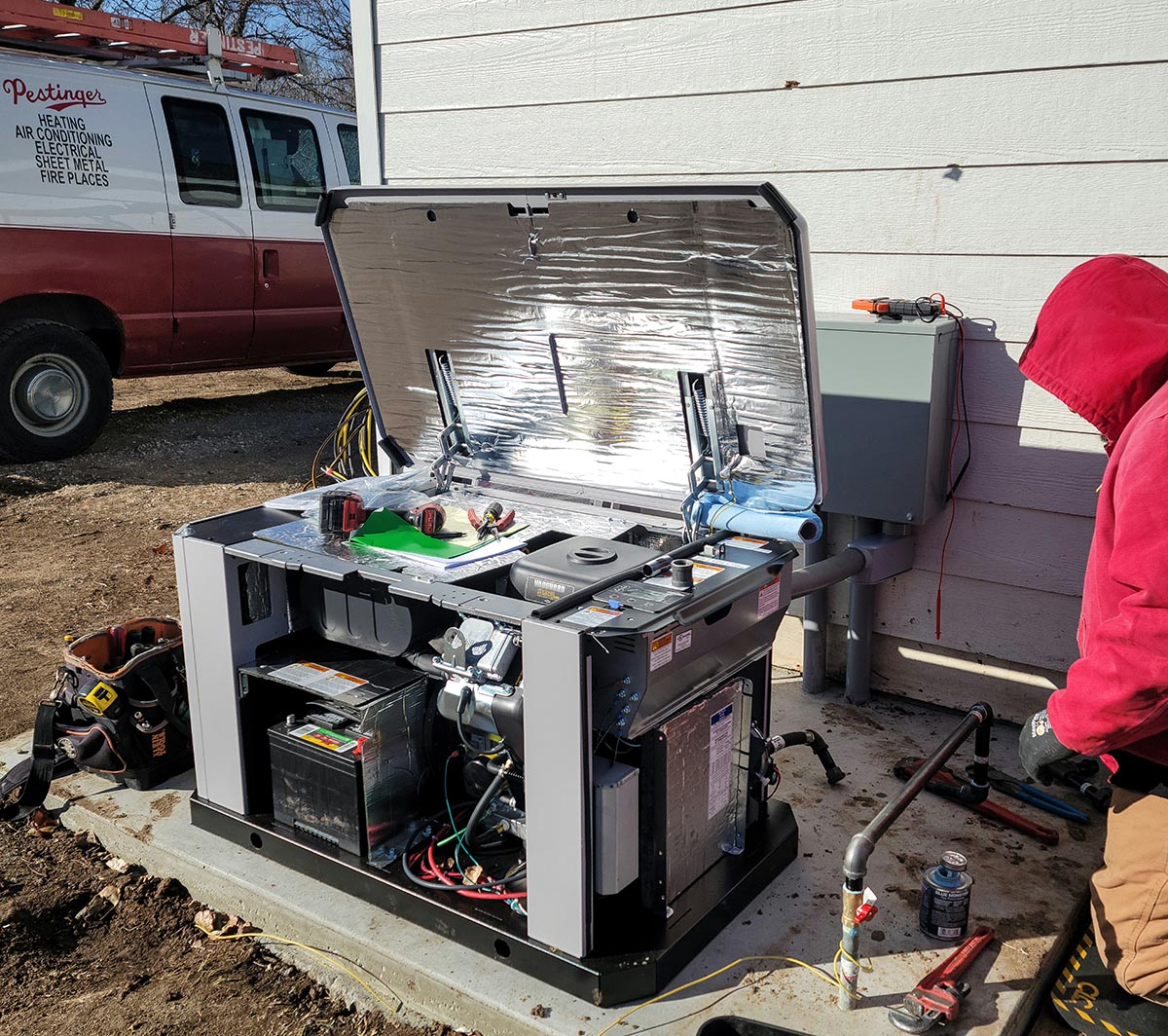
How easy (or challenging) is it to install the Briggs & Stratton standby generator?
A common, if not the most common, question that handy homeowners ask is whether or not they can install a standby generator themselves. According to Buff, installing a Briggs & Stratton generator is a “large project” and that “a licensed electrician and plumber will be involved” to make sure all local and national codes are met.
We found that to be true, but we were still able to save some money on installation by pouring a concrete pad to hold the generator and digging the trenches required for running the new wiring and gas lines from the electric meter to the generator. We used a skid steer to remove the generator from the delivery truck and move it to its new location. The unit weighs about 600 pounds, so we knew we’d need more than just a hand truck to move it.
Pouring a slab is optional, since the company makes a precast concrete pad that can be placed on a level area to hold the generator. On our property, due to its heavy clay soil that expands and contracts, we felt the precast pad might shift over time, so we poured a steel-reinforced concrete slab. Using a precast pad is suitable where the soil is stable. The primary consideration is that the surface that holds the generator is level. According to Buff, a level surface is vital for ensuring “…the engine is able to circulate its oil properly and to make sure the unit is able to shed water, rather than let moisture build up.”
How does the standby generator keep power from backfeeding?
Backfeeding is more of a problem with portable generators than connected standby generators. Backfeeding happens when the user connects a portable generator to an outlet in the home during a power outage, and the electricity runs through the home’s circuits and even backward through the power lines that supply electricity to the house. It can be dangerous—if an unsuspecting lineman is trying to repair a downed power line, back-fed electricity can result in a shock or injury.
Fortunately, that’s not an issue with the Briggs & Stratton generator because it requires the installation of a transfer switch. Buff explained that the transfer switch directs the electricity from the generator to the house and keeps it from backfeeding on the grid’s main lines. “Depending on how you are powering your house, you can either connect the transfer switch to your main service entrance panel or purchase a subpanel that will serve to power only specific applications,” he told us.
For our (rural) installation, the electricians, Drew Oliver and James Todd McGee of Pestinger Heating & Air Conditioning, Salina, Kansas, opted to install the transfer switch outdoors, next to the service entrance panel. From there, the new wiring connects the transfer switch to the generator.
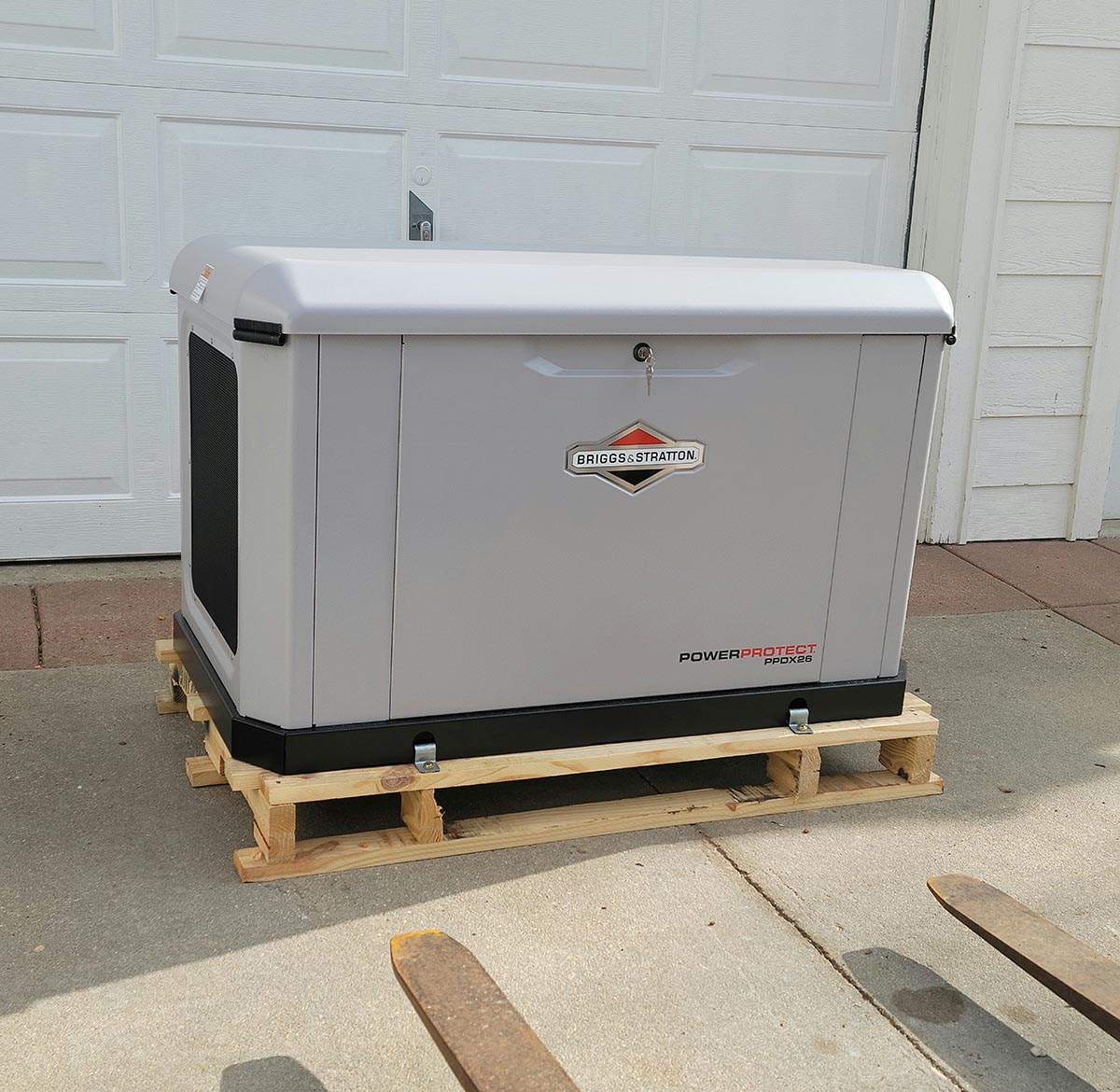
What size standby generator do I need?
The primary purpose of a standby generator is to power a house during a power outage. For this reason, the generator should be powerful enough to supply the electricity needed to run all or most of the home’s appliances, including clothes dryers, HVAC units, microwaves, AC units, and more. If the generator is undersized, homeowners won’t be able to run all of their appliances. If it’s too powerful, it will burn through excess natural gas or propane, generating more power than the home will use.
Briggs & Stratton provides a handy interactive sizing calculator that helps homeowners select the correct-size generator based on their home appliances.
Once we’d installed the standby generator and the electricians ran a preliminary test to determine everything was working as it should, we ran our own test to see if the 26kW standby generator would supply all our needs. We shut off the electrical power to our house at the main disconnect panel. In about 10 seconds, the Briggs & Stratton automatically started running, and we went into the house and turned on all the lights and appliances, one by one. We were a little nervous that the generator might not supply ample power, but it did; it ran every appliance we had.
Most of the time, we aren’t pulling that much power, but it was reassuring to know we could if we had to.
How loud is the Briggs & Stratton standby generator?
We were expecting monstrously loud noise when the standby generator was running, so we had it installed behind our garage, as far away from our main house as possible, but we were pleasantly surprised.
As the electricians started the generator for the first time, we commented on how much quieter it was than we expected. One of the electricians who also regularly installs Generac and Kohler standby generators told us that in his opinion, the Briggs & Stratton generator was notably quieter than either of the other two models.
For an entirely objective measurement beyond the electrician’s opinion, we used a decibel tester. We stood 8 feet from the generator when it was running to take readings, which fluctuated between 70 and 72.5 decibels. That’s comparable to the noise of a dishwasher in operation, or slightly louder. We wouldn’t want it near an open bedroom window, but we could barely hear the generator when we went indoors and opened the house windows. Keep in mind that this is about 60 feet away and behind a garage, a distance that surely dampers the sound.
Where is the best place to locate a standby generator?
Before deciding to invest in a standby generator, note that there are safety requirements for placement. “Make sure you have a location around your home where the generator can be 5 feet away from any opening to the home and has space to accommodate necessary airflow,” Buff said.
Standby generators are very safe when installed correctly, but because they burn fuel to generate power, they put off carbon monoxide (CO). Briggs & Stratton recommends installing a CO detector inside the house, but the safest solution is an ounce of prevention.
In addition to the manufacturer’s requirements, which include not positioning the back of the unit any closer than 18 inches from an exterior wall, we were advised not to plant bushes or locate a fence within 3 feet of the front and sides of the generator. We also learned the generator could not be under an overhang any closer than 5 feet from the top of the unit. These restrictions all reduce the risk of CO accumulating or entering the house. Our local codes did not have any additional location requirements, but check with your local building authority to see if yours does.
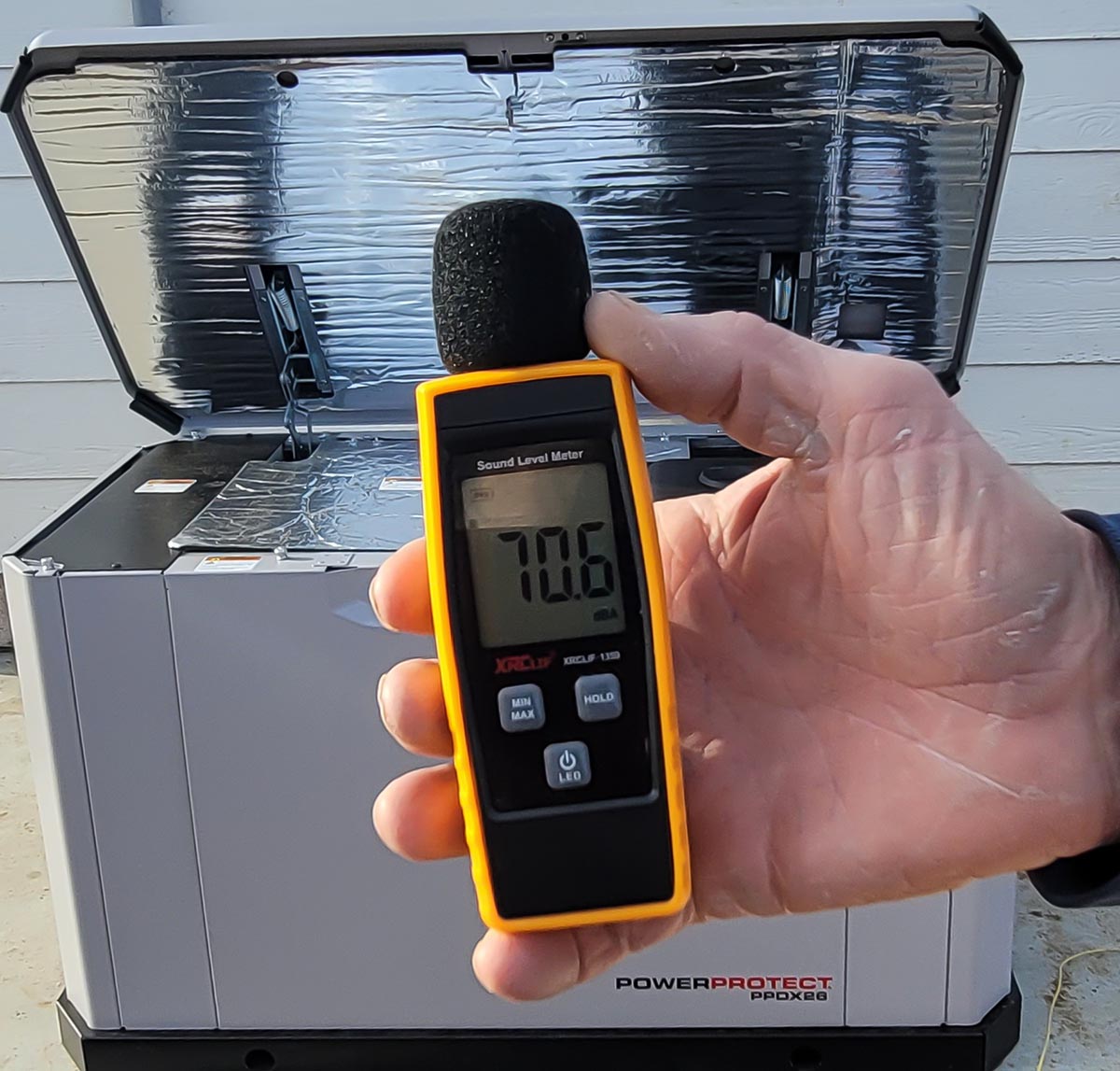
How much does it cost to install a standby generator?
Installing a standby generator isn’t cheap, but you will be glad you invested in one if you live in an area that experiences frequent power outages or if you want extra assurance that your family won’t be without power. To make owning a generator a bit easier on the wallet, Briggs & Stratton offers some helpful financing options. We’d tossed around the idea of installing a standby generator several times after our local utility experienced downed lines, and we ended up with spoiled food because the refrigerator couldn’t keep it cold.
The cost to buy a standby generator will run approximately $4,000 to $10,000, depending on wattage, and that’s just the start. The installation can easily add another $3,000 to $6,000, depending on the particular yard and how much work is necessary.
To save money, we did the prep work ourselves, including forming and pouring the concrete slab, and trenching for the new wiring and gas line. We also purchased the necessary wires, pipes, and conduit ahead of time, which cost about $275, rather than get them from the electrical contractors who would have charged a markup on the materials.
We ended up paying $2,700 for the electricians to connect the transfer switch and the generator. We would have had additional plumbers’ fees to install the new gas lines, but our plumbers were too busy to do the work, so they cleared us to install them. This was possible because we’re licensed contractors, but the average DIYer may need to have a licensed plumber connect the lines, depending on local codes.
The real question is, what is peace of mind worth? Yes, a standby generator will prevent perishable foods from spoiling, but it will also keep a home’s security system operable, keep the lights on, and ensure that any powered medical equipment stays running.
While no definitive studies address how much installing a standby generator will add to the value of a house when it sells, homeowners may realize a 50 to 70 percent return on the investment (ROI). That will ultimately depend on wattage, the home’s value, the age of the unit, and whether the region sees many power outages. With growing grid insecurity, having a standby generator may well be a selling point.
Is the Briggs & Stratton standby generator right for you?
Deciding whether to install a standby generator is a personal choice that requires factoring in the desire for backup power against budget, yard size, and local codes and regulations. Before purchasing one, make sure you’re not subject to HOA rules or neighborhood covenants that restrict the installation of standby generators.
If you get the all-clear and you want the assurance that comes with knowing your home will still have access to power in the event of an outage, then we feel Briggs & Stratton is a worthwhile pick for a backup generator. Although we did not install and test any other generator brands, we discussed the pros and cons with the electricians who installed our unit. They were impressed with how quiet the Briggs & Stratton ran, compared to other models they’ve worked with. We also asked how the overall process of installing our generator compared to that of other brands, and they told us that it was virtually the same. In other words, the same wiring and plumbing concepts are in play no matter the generator brand.
However, if you’re looking to install a standby generator as a DIY project and you aren’t a licensed electrician, you might want to reconsider. Local codes will usually require installation by pros, and you may also have to pull a permit. We’re knowledgeable in basic wiring, but installing the Briggs & Stratton generator was beyond our skill set. In addition, a plumber will probably be necessary to connect the gas line and install the regulators that ensure the correct amount of gas pressure feeds the generator.
So far, we’re impressed with both the power output and the ease of operation of the Briggs & Stratton standby generator. We’ve configured it to run weekly startup tests, and a bright blue light on the front tells us at a glance that the generator is ready at a moment’s notice to start in the event of an outage.
Where to Buy the Briggs & Stratton Standby Generator
Find an authorized Briggs & Stratton standby generator dealer.
Get Briggs & Stratton generators in various sizes at:
- FactoryPure (10kW) for $3,329
- Lowe’s (12kW) for $4,299
- Electric Generators Direct (17kW) for $5,199
- Lowe’s (26kW) for $6,699
Choosing the Right Generator
The best standby generators are powerful units that monitor the flow of electricity into a home and stand ready to start producing power in the event of an outage. Unlike standard portable generators or dual-fuel generators, which can be used to power a few essential appliances, standby generators can produce enough power to run an entire home—without interruption.
Meet the Tester
Glenda Taylor is a product tester and writer specializing in construction, remodeling, and real estate. She and her husband own a general contracting company, and she is experienced in both residential and commercial building applications. She tests a wide range of power tools as well as other home improvement, household, and lawn-and-garden products.
